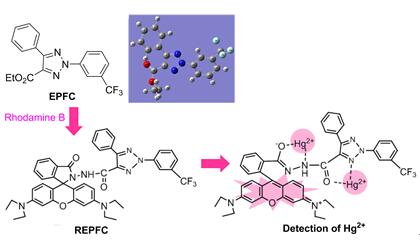| [1] Tornøe, C. W.; Christensen, C.; Meldal, M. J. Org. Chem. 2002, 67, 3057.
[2] Totobenazara, J.; Burke, A. J. Tetrahedron Lett. 2015, 56, 2853.
[3] El-Sayed, N. N. E.; Abdelaziz, M. A.; Wardakhan, W. W.; Mohareb, R. M. Steroids 2016, 107, 98.
[4] Zhao, B. T.; Tao, J. J.; Chen, X. J.; Zhu, W. M. Chin. J. Org. Chem. 2017, 37, 1964(in Chinese). (赵邦屯, 陶晶晶, 陈小纪, 朱卫民, 有机化学, 2017, 37, 1964.)
[5] Aromi, G.; Barrios, L. A.; Roubeau, O.; Gamez, P. Coord. Chem. Rev. 2011, 255, 485.
[6] Maisonial, A.; Serafin, P.; Traikia, M.; Debiton, E.; Thery, V.; Aitken, D. J.; Lemoine, P.; Viossat, B.; Gautier, A. Eur. J. Inorg. Chem. 2008, 2, 298.
[7] Gutknecht, J. J. Membr. Biol. 1981, 61, 61.
[8] Han, Z. X.; Zhu, B. S.; Wu, T. L.; Yang, Q. Q.; Xue, Y. L.; Zhang, Z.; Wu, X. Y. Chin. Chem. Lett. 2014, 25, 73.
[9] Li, X. M.; Zhao, R. R.; Wei, Y. L.; Yang, D.; Zhou, Z. J.; Zhang, J. F.; Zhou, Y. Chin. Chem. Lett. 2016, 27, 813.
[10] Xiao, H. F.; Zhang, M.; Liu, J.; Han, Z. X.; Yang, L. Q.; Wu, X. Y. Chin. J. Org. Chem. 2016, 36, 2413(in Chinese). (肖慧丰, 张敏, 刘杰, 韩志湘, 仰榴青, 吴向阳, 有机化学, 2016, 36, 2413.)
[11] Chen, Y.; Chen, B.; Han, Y. F. Sensor Actuators, B 2016, 237, 1.
[12] Jeong, Y. S.; Yoon, J. Y. Inorg. Chim. Acta 2012, 381, 2.
[13] Wechakorna, K.; Suksenc, K.; Piyachaturawat, P.; Kongsaeree, P. Sensor Actuators, B 2016, 228, 27.
[14] Erdemir, S.; Malkondu, S. J. Lumin. 2015, 158, 401.
[15] Erdemir, S.; Kocyigit, O.; Malkondu, S. J. Photochem. Photobiol., A 2015, 309, 15.
[16] Shen, B. X.; Qian. Y. Sens. Actuators, B 2017, 239, 226.
[17] Lv, Y. L.; Zhu, L. L.; Liu, H.; Wu, Y. S.; Chen, Z. L.; Fu, H. B.; Tian, Z. Y. Anal. Chim. Acta 2014, 839, 74.
[18] Wang, H.; Chen, B. B.; Zhu, S. Q. Anal. Chem. 2016, 88, 796.
[19] Amiri, N.; Rofouei, M. K.; Ghasemi, J. B. Anal. Methods 2016, 8, 1111.
[20] Lee, S.; Rao, B. A.; Son, Y. A. Sens. Actuators, B 2015, 210, 519.
[21] Jadhav, S.; Bakker, E. Anal. Chem. 2001, 73, 80.
[22] Wu, L. Y.; Guo, S.; Wang, X. H.; Guo, Z. F.; Yao, G. G.; Lin, Q.; Wu, M. S. Tetrahedron Lett. 2015, 56, 2145.
[23] Anusuya, N.; Sounthari, P.; Saranya, J.; Paramswar, K.; Chitra, S. Orient. J. Chem. 2015, 31, 1741.
[24] Zhan, D. L.; Gao, N.; Han, W. W.; Feng, Y. Chem. J. Chin. Univ. 2014, (1), 146(in Chinese). (詹冬玲, 高楠, 韩葳葳, 冯雁, 高等学校化学学报, 2014, (1), 146.)
[25] Li, X. H.; Cui, H. L.; Zhang, R. Z.; Zhang, X. Z. Spectrochim. Acta, Part A 2015,137, 321
[26] Kurtz, H. A.; Stewart, J. J. P.; Dieter, K. M. J. Comput. Chem. 1990, 11, 82.
[27] Zhu, M. H.; Hu, P. Instrumental Analysis, 4th ed., Higher Education Press, Beijing, 2008, pp. 335~345(in Chinese). (朱明华, 胡坪, 仪器分析, 第四版,高等教育出版社, 北京, 2008, pp. 335~345.)
[28] Xu, J. G.; Wang, Z. B. Fluorescence Analysis, 3rd ed., Science Press, Beijing, 2006, pp. 53~56(in Chinese). (许金钩, 王尊本, 荧光分析法, 第三版, 科学出版社, 北京, 2006, pp. 53~56.)
[29] Chen, W. Q.; Jin, G. Y. Chin. J. Appl. Chem. 2000, 17, 479(in Chinese). (陈卫强, 金桂玉, 应用化学, 2000, 17, 479.)
[30] SaSaki, H.; Hanaoka, K.; Urano, Y.; Teral, T.; Nagano, T. Bioorg. Med. Chem. 2011, 19, 1072.
[31] Jiang, C. C.; Wang, M.; Wang, Y. X.; Tang, X. N.; Zhang, Y. M.; Zhang, H.; Ma, L.; Wang, J. Y. Tetrahedron Lett. 2017, 58, 2560.
[32] Zhang, X. B.; Gong, Y. J.; Su, L.; Mao, G. J. J. Nanjing Normal Univ. (Nat. Sci. Ed.) 2015, (2), 1(in Chinese). (张晓兵, 龚毅君, 苏莉, 毛国江, 南京师大学报(自然科学版), 2015, (2), 1.)
[33] Ge, F.; Ye, H.; Luo, J. Z.; Wang, S.; Sun, Y. J.; Zhao, B. X.; Miao, J. Y. Sens. Actuat. B 2013, 181, 215.
[34] Wang, X. X.; Li, X. L.; Shi, W.; Wei, S.; Giesy, J. P.; Yu, H. X.; Wang, Y. L. Ecotoxicol. Environ. Saf. 2013, 89, 143.
[35] SYBYL Software, Version 6.9, St. Louis, Tripos Associates Inc, 2002.
[36] Chou, Y. C. Comput. Theor. Chem. 2015, 1069, 112.
[37] Gupta, R. C.; Razi, S. S.; Ali, R.; Dwivedi, S. K.; Srivastava, P.; Singh, P.; Koch, B.; Mishra, H.; Misra, A. Sensor Actuators, B 2017, 251, 729.
[38] Bhatta, S. R.; Bheemireddy, V.; jaykumar, G. V.; Arunabha Thakur, A. Sens. Actuators, B 2017, 240, 640.
[39] Wu, J. D.; Lu, J. R.; Liu, J. G.; Zheng, C. H.; Gao, Y. X.; Hu, J.; Ju, Y. Sens. Actuators, B 2017, 241, 931.
[40] Wang, L. Y.; Fang, G. P.; Ye, D. C.; Derong Cao, D. R. Sens. Actuators, B 2017, 195, 572.
[41] Wang, N. J.; Sun, C. M.; Chung, W. S. Tetrahedron 2011, 67, 8131.
[42] Mandal, D.; Thakur, A.; Ghosh, S. Polyhedron 2013, 52, 1109.
[43] Cao, Q. Y.; Han, Y. M.; Wang, H. M.; Xie, Y. Dyes Pigm. 2013, 99, 798.
[44] Sulak, M.; Kursunlu, A. N.; Girgin, B.; Özlem Özen Karaku?, Ö. Ö.; Güler, E. J. Photochem. Photobiol., A 2017, 349, 129. |
